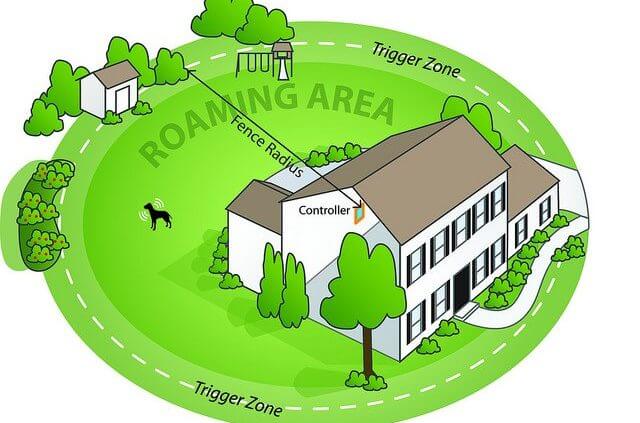Dog Fencing Ideas, How To Decide
Hi, there whilst you are researching for dog fencing ideas you will see there are many different types of dog fencing from standard fencing to electronic or even invisible fencing options.
Why Do You Need A Fence?
Most pet owners, at some point, have an issue with a dog that likes to take themselves for a walk; loves to jump the back fence (even if its 6ft tall) or is a serial digger, who can move soil like you’ve never seen before. A dog will quite happy at escape in search of things to chase, other people meet or jump up, pets to socialise with or simply because they feel its time for a walk.
Not all people like dogs, they could be frightened of a dog who is roaming without its owner. As a pet owner, it is your responsibility to ensure not only the safety of your dog but the risk an escaped dog poses to others. This is not to say that your pet is vicious and will attack. Most likely too friendly and may knock someone over or has no road sense and causes an accident.
The Positives of Fencing:
- Your pet is safe from harm.
- Other people are safe from your pet.
- No paying the dog warden to get your pet back which are over £50 a time can mount up, especially if you have a frequent escape artist.
- Unexpected vet bills, will not be due to injury or poisoning or worse being shot by a farmer.
- No unexpected puppies, if your dog has not been spayed or neutered.
- You don’t end up having to pay for other vet bills for another injured animal.
- Peace of mind that your pet cannot escape.
- Your dog will not cause an accident (accidents caused by dogs are on the increase)
Dog Fencing Idea’s
Wooden Panel Dog Fencing Ideas
What height do you need 3ft, 4ft, 6ft – wooden panel fencing may well look like it provides a secure area but other than the fence posts, the panels sit above the ground. The enables a dog to dig their way out under a wooden fence. Or perhaps your pet is energetic, can jump high – is a 6ft fence going to hold them back? Maybe you have a 3ft fence and are considering a higher one? What will this do for a dog that can jump? The answer is simple, it will only teach them to jump higher and higher. It’s better to start high so you do not have to foot the bill to replace fencing panels trying to retain your pet.
You may also need to place obstacles to deter jumping or plant bushes, or you can pay out even more money for an angled roof section which slopes inwards at the top of your fence. To maintain a wooden fence costs money and effort; wood treatment to stop rotting or repairs from weather damage.
This option can be quite costly to you and you cannot leave your dog unattended in a fenced garden.
Wire Mesh Dog Fencing Ideas
One word – Barking – caused by barrier frustration that your dog can see others and is either guarding or demanding their attention as they pass by. Of course, a dog left out all day can boredom bark and a wire mesh fence allows for others who cannot stand the barking to an opportunity to be able to tease, release, injure or even poison your pet, yes this does happen!
Dogs do bark when they hear things, but more so when they can also see but feel enclosed they try to alert their owner to someone else’s visual presence. It can also cause fence running due to frustration. To combat this you would not be able to leave your dog unattended in a fenced garden.
Chaining Your Dog Up
This is a recipe for aggression and a lack of exercise for your pet. Unable to seek shelter from weather unless you invest in the cost of building a shelter for them. I guess the question you need to ask if you are even thinking of this is would you like to be chained up for long periods of time? This is not really a freedom fence or a fair form of containment.
Wireless Dog Fencing Ideas
And so we have the solution……the inescapable fence – or is it?
Well, the answer depends on what type of wireless fence system you go for:
The AM Frequency Wireless Dog Fence:
- Many household appliances including televisions, WiFi, computer monitors, light dimmers, motors, etc emit a noise-based signal that AM receivers “hear” and incorrectly acknowledge as their own signal, triggering an unwanted response.
- AM receivers can be confused and accidentally trigger as the receiver assumes the signal is correct.
- AM systems use two signals, to try to alleviate the problem, but this slows the reaction time down. On both the start-up and shut off time on the receiver. This is why dogs and cats can “outrun” the signal on AM systems. The pet also continues to be corrected with shocks from their collar, when outside the fencing zone.
- The AM signal is usually pulsed using an on/off the transmission, however, when in the off state is where interference with other AM signals can occur causing the receiver to miss the total signal.
- False activation can happen because AM receivers do not ignore all noise-based signals.
- Pets are able to run through an AM signal and then most AM systems continue to shock your pet over and over once outside the boundary.
The FM Frequency Legal Wireless Dog Fence:
-
- A safer and quicker than AM and ignores AM signals
- A secure digital signal, which ensures no interference is received.
- FM receivers only hear their own transmission so no false activation occurs especially where patented Safelink technology is used.
- The FM transmission is a fast signal and more energy efficient.
- FM signals can work in electrical noise environments.
- Transmitters can be used near or against electrical appliances.
- The output power remains constant.
- Wireless dog fences transmitters can be attached to metal or stock fencing, without signal loss.
- The FM signal eliminates the risk of false correction and necessary shocks to your pet.
- The FM frequency hidden dog fence provides an uncrossable barrier for your pet.
- The shock collar has a safety cut-off, this ensures there is no continuous shocks delivery, in the unlikely event of a boundary breach.
- Costs a fraction of the price of alternative fencing ideas.
To conclude the best dog fencing idea if you want to ensure your pet cannot escape into harm’s way is to opt for an FM frequency wireless fence. Dog Fence has provided this system to tens of thousands of pet owners throughout the UK. If you are serious about keeping your pet safe and happy with the freedom of an invisible fence take the time to have a conversation with the team at Dog Fence by getting in touch today. Call us on 03450 623623 or email to info@dogfence.co.uk. One of our team would be happy to talk to you about your dog fencing ideas and requirements.










